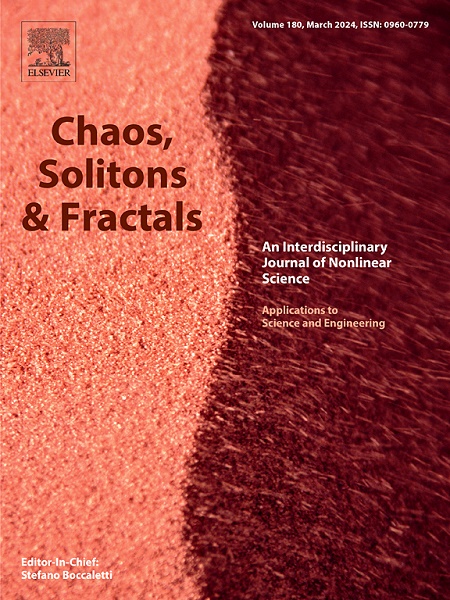Improved fixed-time sliding mode synchronization control of a new 4-cell memristive CNN chaotic system with the offset boosting via certain self-parameters
IF 5.3
1区 数学
Q1 MATHEMATICS, INTERDISCIPLINARY APPLICATIONS
引用次数: 0
Abstract
A new 4-cell memristive cellular neural network (CNN) is proposed, in which a current-controlled generic memristor substitutes the resistor in one cell’s output. Within the CNN system, various dynamic behaviors are generated, including symmetrical and asymmetrical double-wing chaotic attractors, single-wing chaotic attractors, and periodic attractors, resulting from bifurcation phenomena with two memristor parameters varying. More interestingly, the remaining two memristor parameters pose partially amplitude control and offset boosting to the variables or dynamics of the CNN system, due to no bifurcation phenomena by varying them. The theoretical findings are validated by circuit realization. Moreover, an improved sliding mode synchronization control for the proposed CNN system with external disturbance and non-modeled dynamics is introduced. Under the sliding mode control, the responsive system in the secure communication can achieve synchronization with the driving system, both of which are specified by the proposed CNN system. The synchronization time is fixed and independent of their initial conditions. The synchronization control strategy is robust in a degree, as the synchronization is achieved and the synchronization times are nearly indistinguishable for CNNs both with and without disturbances and non-modeled dynamics, while solving the problem of chattering. Moreover, the synchronization time can be shorten by parameters of the sliding mode surface and the controller, as well as the parameter of the additional term through decreasing the overshoot of the convergence process of the synchronization error system. Finally, all the performances are validated by numerical simulations. The research findings pave a way for future applications to secure communications.
一种新型4单元记忆CNN混沌系统的改进定时滑模同步控制
提出了一种新的四单元忆阻细胞神经网络(CNN),其中电流控制的通用忆阻器取代了一个单元输出的电阻。在CNN系统内部,由于两个忆阻器参数变化的分岔现象,会产生各种动态行为,包括对称和不对称的双翼混沌吸引子、单翼混沌吸引子和周期吸引子。更有趣的是,其余两个忆阻器参数对CNN系统的变量或动态具有部分幅度控制和偏置增强作用,因为通过改变它们不会产生分岔现象。通过电路实现验证了理论结果。此外,还介绍了一种改进的滑模同步控制方法,用于具有外部干扰和非建模动态的CNN系统。在滑模控制下,安全通信中的响应系统可以与驱动系统实现同步,这是本文提出的CNN系统所规定的。同步时间是固定的,与初始条件无关。该同步控制策略在一定程度上具有鲁棒性,在解决抖振问题的同时,对有无干扰和非建模动态的cnn都实现了同步,且同步时间几乎无法区分。此外,通过减小同步误差系统收敛过程的超调量,可以利用滑模面参数和控制器参数以及附加项参数来缩短同步时间。最后,通过数值仿真验证了所有性能。研究结果为未来安全通信的应用铺平了道路。
本文章由计算机程序翻译,如有差异,请以英文原文为准。
求助全文
约1分钟内获得全文
求助全文
来源期刊

Chaos Solitons & Fractals
物理-数学跨学科应用
CiteScore
13.20
自引率
10.30%
发文量
1087
审稿时长
9 months
期刊介绍:
Chaos, Solitons & Fractals strives to establish itself as a premier journal in the interdisciplinary realm of Nonlinear Science, Non-equilibrium, and Complex Phenomena. It welcomes submissions covering a broad spectrum of topics within this field, including dynamics, non-equilibrium processes in physics, chemistry, and geophysics, complex matter and networks, mathematical models, computational biology, applications to quantum and mesoscopic phenomena, fluctuations and random processes, self-organization, and social phenomena.
 求助内容:
求助内容: 应助结果提醒方式:
应助结果提醒方式:


